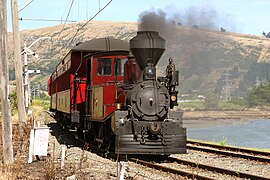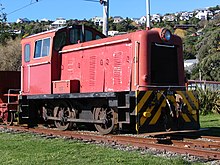Ferrymead Railway
| Ferrymead Railway | |
|---|---|
|
D-Class N o 140 of the Ferrymead Railway
| |
| Route length: | 0.5 km |
| Gauge : | 1067 mm ( cape track ) |
The Ferrymead Railway of Canterbury Railway Society is a museum railway , which the station Ferrymead of Ferrymead Heritage Park in the city of Christchurch on the south east coast of the South Island of New Zealand leads. It was both the first railroad to operate in New Zealand and the first to shut down.
First beginnings
The original line was with the broad gauge - gauge of 1,600 mm (5 feet 3 inches built) to imported rolling of Melbourne and Essendon railway company in the Australian state of Victoria to use. It was used to load and unload ships in Ferrymead. When the tunnel to Lyttelton Harbor was completed in 1867, there was little traffic on the railway line. After July 27, 1868, the line was used as a siding and the station buildings moved to Christchurch and Heathcote .
The Museum of Science and Industry , as it was called at the time, was launched in Christchurch in the early 1960s when a group of like-minded people came together to run a pilot project on Garvins Road in Hornby .
Ferrymead Heritage Park
It was decided that the site, later named Ferrymead Heritage Park, would receive both railroad and tram tracks, the latter operated by the Tramway Historical Society to connect the entrance to an open-air museum of a historic village. Club members from the Canterbury area began building the Ferrymead Railroad with infrastructure and facilities, including the workshop, engine shed, stations, signaling and other facilities. From 1964, the Eisenbahnfreunde laid new narrow-gauge railroad tracks with 1067 mm (3 feet 6 inches) gauge on the old route. The first trains started running in 1972, and the official opening took place in 1977. Until then, the locomotives and railroad cars were transported to the site by road scooters or trucks . In 1978 the line was connected to the main line of the New Zealand Railways at Heathcote via a provisional line in order to bring the larger locomotives, the Vulcan railcars and other rail vehicles onto the site.
At the end of the 1970s, the construction of the electrified section of the railway began, with materials and assemblies of the former overhead line between Christchurch and Lyttelton, as well as between Arthur's Pass and Otira . After the NZR's D G class diesel-electric locomotives were decommissioned in 1983, a separate company, the Diesel Traction Group, was founded to maintain this class of the Ferrymead Railway and later also the D E class and D I - diesel locomotives . Class to acquire. In 1988, an electric multiple unit set of the NZR M-Class consisting of a DM 320 multiple unit and the D 2695 car was purchased.
In 1990 the NZRLS Canterbury Branch was reconstituted as the Canterbury Railway Society (CRS) . Restructuring of New Zealand Railways, which began in the early 1980s, resulted in the closure of rail facilities and gave the CRS further opportunities to acquire additional vehicles. Changes in labor law and its subsequent impact on New Zealand society after 1990 had a major impact on rail maintenance organizations in New Zealand, particularly with regard to voluntary workers. The economic recession of 1991 also had an impact on the CRS. Ferrymead Heritage Park ran into economic difficulties as a result of the decline in visitor numbers caused by the economic downturn.
Current development
In 1995, Ferrymead Historic Park was taken over by Christchurch City Council after its financial losses became unsustainable. Since that time there have been a number of changes in the way the park is run, with a greater reliance on volunteer work. The Ferrymead Railway now runs only intermittently to cope with the decline in visitor numbers in the winter months and to allow vehicle maintenance to continue.
In 2005, plans for a National Rail Museum were published. The construction of the first stage will cost approximately NZ $ 3.5 million. Other plans included electrification between Moorhouse and Ferrymead stations, which was completed in 2009, and the extension of the line from Moorhouse to a new station in the valley.
The earthquakes of September 2010 and February 2011 caused significant damage to the infrastructure around the museum, including the railroad. Repairs were needed to get the railroad running again after the authorities gave the all-clear. The railway was operated at its capacity limit again from Easter 2012. This was seen as a success for the city of Christchurch and a moral boost after a year of devastation.
Web links
Coordinates: 43 ° 34 ′ 4.4 ″ S , 172 ° 42 ′ 8.3 ″ E

